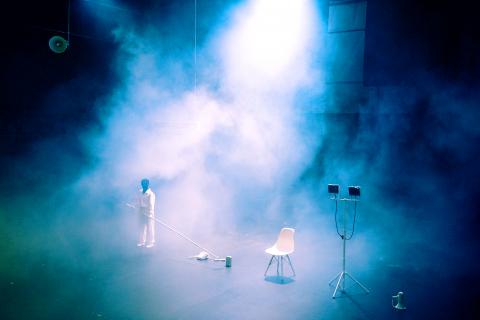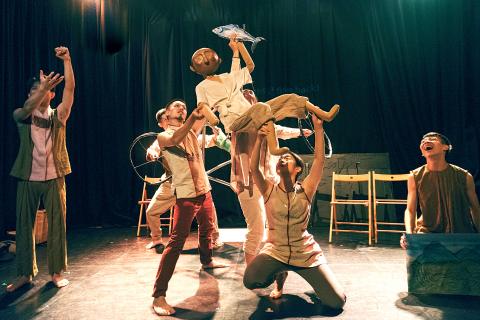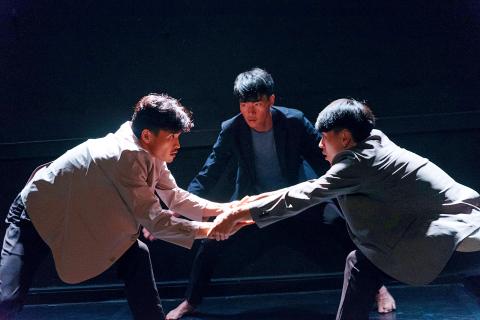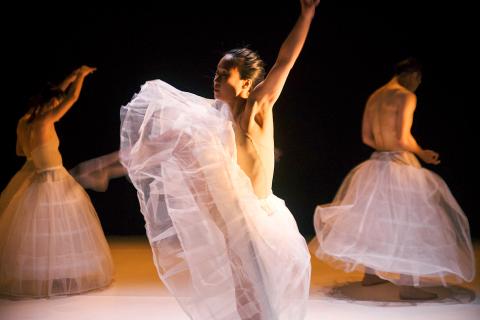There is a certain madness about Edinburgh in August. Creativity and optimism fill the air as streets throng with visitors and artists who flock to the city for the Edinburgh International Festival, but especially the Edinburgh Festival Fringe, which this year had a record 63 countries represented with 59,600 performances of 3,841 shows in 323 venues; all in just four weeks. The festival ended yesterday.
Now in its sixth year, the Taiwan Season 2019 at the Fringe featured a quartet of diverse dance and theater productions. All attracted critical praise and excellent reviews.
Summerhall is a venue that particularly buzzes with energy. A year-round arts center that focuses on quality experimental work, the building’s history as a former veterinary school makes itself felt in its various unique performance spaces.

Photo: Lucas Kao
CHANG DANCE THEATER
In the Old Lab, a compact 72-seat black box space with a stage just 8m by 5m, Chang Dance Theater (長弓舞蹈劇場) played to packed audiences with Bout. Like their Edinburgh hit last year, Bon 4 Bon, it looks at brotherly relationships, this time through the ritual and physicality of the boxing ring.
Bout has tension, focus and energy, even in moments of silence or stillness. The tight space and its black walls focus the attention superbly. They intensify and bind the action, just as boxing is bound to the ring, except here there is no chance of going through the ropes.

Photo: Etang Chen
Relationships between the three brothers, Chang Chien-hao (張堅豪), Chang Chien-kuei (張堅貴) and Chang Ho-chien (張鶴千), are strong but sometimes strained. Boxing motifs find their way naturally into the choreography. They support each other as brothers do, but shadow boxing and play fighting turns easily into the real thing. Sometimes they quite literally stand toe to toe, sparring and grappling, one of the three acting as referee and peacemaker.
Audience comments say it all: “Beautiful chemistry,” wrote one in a book the brothers are keeping. “Truly special work. Human, visceral, masculine, inventive,” said another.
SHINEHOUSE THEATER

Photo: Lucas Kao
Across the courtyard in Summerhall’s Cairns Lecture Theater, Shinehouse Theater (曉劇場) presented Fish (魚). Based on a short story by Taiwanese author Huang Chun-ming (黃春明) and directed by Chung Po-yuan (鍾伯淵), it’s an engaging tale of a boy and his grandfather, and of an unfulfilled promise to bring home a fish. Told through spoken word in Mandarin and Taiwanese (with English translation), British Sign Language and puppetry, it’s a touching story of hardship and unfortunate events that lead to conflict and injustice.
Each company member takes on various roles but at the show’s heart is the puppet that is the boy, Acha. Despite its pale clothes and having no eyes and mouth, the cast conjure remarkable expression from it. It is like a simple sketch that has delightfully come to life. Scene changes are shown through equally pleasing portable picture boards, including a super bus.
The story moves quite swiftly at times. There’s also a lot going on. Some in the audience, largely unfamiliar with such use of puppetry, found it difficult to follow at first but all relate to the story’s poignancy, especially at the end.

Photo: Lucas Kao
Very accessible, Fish proves again that language is not necessarily a barrier and that, presented well, Taiwanese drama can work overseas.
TSAI PO-CHENG AND B.DANCE
Taiwan dance lovers have long noted the talent of choreographer Benson Tsai (蔡博丞). Edinburgh Fringe audiences have now discovered him too, with his Floating Flowers (浮花) by B.DANCE (丞舞製作團隊) playing to sell-out audiences at Dance Base, Scotland’s National Center for Dance.

Photo: Lucas Kao
Dressed in white full-length, hooped, tulle skirts, four male and four female dancers paint stunningly beautiful images as they glide around the stage, symbolizing the candle-lit floating lanterns that are set afloat during the Ghost Festival. Like lanterns on the water, the performers are always on the move. Wrists, fingers, fold and unfold like the flickering flames of candles, each painting its own pictures. Super-pliant upper bodies twist and bend. It’s an expression of spirit as much as of body.
The final sections are increasingly pushed on by Li Ming-chieh’s (李銘杰) driving soundtrack. The dance becomes increasingly fast-paced and energetic as the gentle breezes of the beginning turn into a driving storm.
Like almost all choreographers, Tsai has had to adapt his work for the festival, in particular here presenting it without projections. That has turned out to be a happy necessity. Tsai’s dance doesn’t need any support and the white of the dancers sits perfectly against the black background.
Dance works presented at the Fringe can sometimes be overly pretentious, too bound up in concept and forget the moving body. Floating Flowers and Bout are a couple of perfect antidotes to that.
MONSTER
White is also the dominant color in Monster (怪獸) by Liu Yen-Cheng (劉彥成) for Dua Shin Te Production (大身體製造), also at Dance Base, although it could scarcely be more different.
Liu’s experimental work about the monster within us all has divided critics. While most have welcomed its difference and daring, national critics in particular have found it confused and lacking direction. Certainly, an inordinate amount of time is spent setting the stage, mostly hoisting a digital display that is used to screen various, often philosophical messages. That text, a recorded voice and the hazy setting becomes the focus of the work rather than any movement, of which there is little. Even one critic who gave it five stars commented that it became boring.
When Liu does finally dance, it just looks awkward and clumsy with little sense of any monsters within. More intriguing is Liu Yu-fan (劉語凡), who stands center, holding a pole with a microphone attached. Always there, almost always still, faceless and in white, she’s an enigmatic presence, doing much while doing little.
Monster may not be the “psychedelic fantasy” of its publicity. It may not even be dance in some people’s eyes, but it does show the breadth of creativity in the arts in Taiwan; and variety is what the arts, the Taiwan Season, and the Edinburgh Fringe generally, should be all about.

On April 26, The Lancet published a letter from two doctors at Taichung-based China Medical University Hospital (CMUH) warning that “Taiwan’s Health Care System is on the Brink of Collapse.” The authors said that “Years of policy inaction and mismanagement of resources have led to the National Health Insurance system operating under unsustainable conditions.” The pushback was immediate. Errors in the paper were quickly identified and publicized, to discredit the authors (the hospital apologized). CNA reported that CMUH said the letter described Taiwan in 2021 as having 62 nurses per 10,000 people, when the correct number was 78 nurses per 10,000

As we live longer, our risk of cognitive impairment is increasing. How can we delay the onset of symptoms? Do we have to give up every indulgence or can small changes make a difference? We asked neurologists for tips on how to keep our brains healthy for life. TAKE CARE OF YOUR HEALTH “All of the sensible things that apply to bodily health apply to brain health,” says Suzanne O’Sullivan, a consultant in neurology at the National Hospital for Neurology and Neurosurgery in London, and the author of The Age of Diagnosis. “When you’re 20, you can get away with absolute

May 5 to May 11 What started out as friction between Taiwanese students at Taichung First High School and a Japanese head cook escalated dramatically over the first two weeks of May 1927. It began on April 30 when the cook’s wife knew that lotus starch used in that night’s dinner had rat feces in it, but failed to inform staff until the meal was already prepared. The students believed that her silence was intentional, and filed a complaint. The school’s Japanese administrators sided with the cook’s family, dismissing the students as troublemakers and clamping down on their freedoms — with

As Donald Trump’s executive order in March led to the shuttering of Voice of America (VOA) — the global broadcaster whose roots date back to the fight against Nazi propaganda — he quickly attracted support from figures not used to aligning themselves with any US administration. Trump had ordered the US Agency for Global Media, the federal agency that funds VOA and other groups promoting independent journalism overseas, to be “eliminated to the maximum extent consistent with applicable law.” The decision suddenly halted programming in 49 languages to more than 425 million people. In Moscow, Margarita Simonyan, the hardline editor-in-chief of the